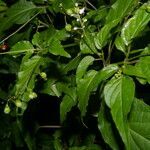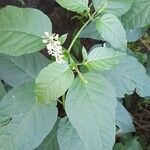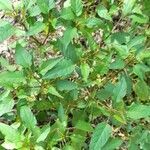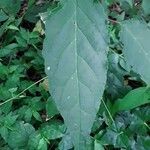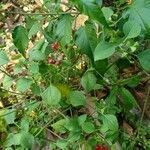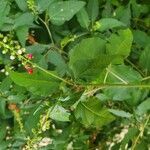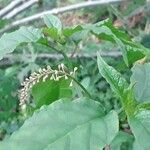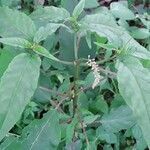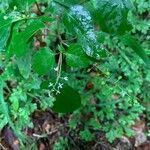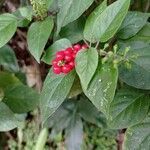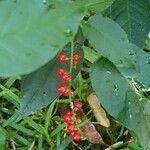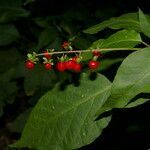Erect herb 3–10 dm. tall, glabrous to densely hairy on the branchlets, but commonly with short weak bristly hairs only on the ridges of the youngest parts.. Leaf-blades lanceolate to elliptic-ovate or ovate, mostly 5–12(–17) cm. long, 2.5–6(–8) cm. wide, acuminate, broadly cuneate to rounded or cordate and unequal-sided at the base, glabrous to densely hairy, but commonly with small hairs only on the midrib above and on the nerves beneath; crystals often visible as short raised lines beneath; primary lateral nerves 6–12 on either side; petiole slender, 1.5–4.5(–6) cm. long, adaxially pubescent.. Racemes 3–5(–11 in fruit) cm. long, sublaxly many-flowered; bracts caudate from a broader basal part, ± 1 mm. long, caducous; pedicels slender, becoming recurved, 1.5–3(–5 in fruit) mm. long, with minute bracteoles on the upper part.. Sepals green, white or pinkish, ± 2 mm. long, spreading at anthesis.. Stamens a little shorter than the sepals.. Ovary a little shorter than the sepals.. Berry 3–4 mm. in diameter, ripening red.. Seeds 2–2.4 mm. across, usually shortly hairy.. Fig. 3.
Straggling shrubs or tall herbs sometimes-woody at the base, up to 10 meters high. Leaves elliptic to ovate or lanceolate, the apex acute to acuminate, the base rounded or truncate, 2-6 cm. wide, 4-12 cm. long; petioles 0.6-11.0 cm. long. Flowers small, drooping; pedicels 3 mm. in flower, elongating to about 7 mm. in fruit; bracts lanceolate, about 2 mnm. long; tepals 4, white or pinkish white, 2.0-3.5 mm. long; stamens 4, inserted at the base of the perianth, about 1.5 mm. long. Fruit a scarlet or red berry, about 4.0-4.5 nmm. in diameter. Florida to Oklahoma and Texas; throughout Mexico and southward to Argen-tina; West Indies. In Costa Rica found up to 1040 meters elevation. Particularly common on waste ground, often on coastal rocks. Among the common names are Wild Tomato, Bloodberry, and car-min.
Erect herb, often woody at base and shrublike, to 2 m high, usually below 1 m, shortly pubescent or sparsely puberulent. Leaves ovate-oblong to ovate-lanceolate, acuminate or acute; lamina to 12 cm long and 4 cm wide, glabrous above; base obtuse, rounded or subcordate; petiole to 5 cm long. Racemes many-flowered, erect to slightly spreading, 4–12 cm long; pedicels 2–3 mm long each with a bract to 4 mm long and a pair of minute bracteoles. Tepals 2–3 mm long, white or pink, reflexed and green in fruit. Ovary globose; style 0.5 mm long; stigma capitate. Berry globose or pyriform, 3–4 mm diam., red or orange. Seed ovoid, c. 2 mm long, hairy.
A herb or shrub. It grows 1-2 m high. The stems are erect and slender. They are often woody near the base. The leaves are alternate and taper to the tip. They are 4-12 cm long by 2-4 cm wide. They are bright green. They are sword shaped with a rounded shoulder at the base. The leaf stalk is about the same length as the leaf blade. The flowering cluster is near the ends of branches and is like a slender spike. The flowers are small and white. The fruit is round or pear shaped. They are 3-4 mm across. It is bright red. There is one seed inside. The seeds are black. The crushed leaves have a strong smell.
Plants 30-100 cm tall. Branches spreading, pubescent when young. Leaves rather remote; petiole 1-3.5 cm, pubescent; leaf blade ovate or ovate-lanceolate, 4-12 × 1.5-4 cm, abaxially pubescent along midvein, adaxially glabrous, base attenuate, margin slightly serrulate, apex long acuminate. Racemes 4-10 cm (including peduncle), pubescent. Pedicel slen-der, with a bract and a pair of bracteoles. Tepals white or pink, elliptic or obovate-oblong, 2-2.5 mm, in fruit 3-3.5 mm, green, reflexed. Stamens shorter than and alternate with tepals. Berry globose or pyriform, 3-4 mm. Seeds ca. 2 mm. 2n = 126.
Plants erect, straggling, or vinelike, 0.4-2 m, ± glabrous or densely pubescent. Leaves: petiole 1-11 cm; blade lanceolate, elliptic, or oblong to deltate or ovate, to 15 × 9 cm, base cuneate or rounded to truncate or cordate, apex acuminate or acute to obtuse or emarginate. Racemes 4-15 cm; peduncle 1-5 cm; pedicel 2-8 mm. Flowers: sepals white or green to pink or purplish, elliptic or oblong to oblanceolate or obovate, 1.5-3.5 mm; style often curved. Berries 2.5-5 mm diam. Seeds lenticular, 2-3 mm, enclosed in thin, densely pubescent membranes. 2n = 108.
Leaves: lamina 2.0–10.0 × 1.0–4.5 cm., elliptic to ovate, cuneate to rounded at base, usually acuminate, glabrescent to pubescent above and below, often particularly along main veins; petioles 8–50 mm. long, thickly pubescent all round (not in the Flora Zambesiaca area) to pubescent along upper side only or glabrescent.
Sepals c. 2 × 0.8–1 mm., elliptic, rounded to slightly acute at apex, spreading at anthesis, green, white or pinkish.
Herb, up to 0.7 m high. Leaves ovate. Inflorescence an axillary raceme. Berries red when ripe. Flowers white.
Stamens 1.5–1.8 mm. long; filaments often persistent in fruiting; anthers 0.4–0.5 mm. long.
Bracteoles 2, appressed to sepals, triangular, 0.2–0.25 × 0.2–0.25 mm.
Stems glabrous or slightly pubescent at nodes.
Flowers glabrous; pedicels to 5 mm. long.
Herbs or (?)sub-shrubs 0.30–1.2 m. tall.
Bract 1, 1–1.2 mm. long, subulate.
Style 0.4–0.5 mm. long, filiform.
Inflorescences to 13 cm. long.
Ovary 0.5–0.6 mm. in diam.
Fruit 2.5–3 mm. in diam.
Seed c. 2 mm. in diam.
